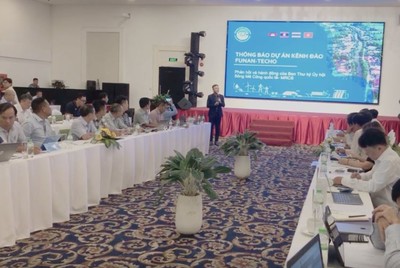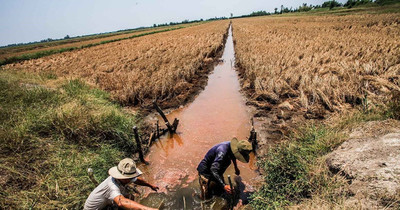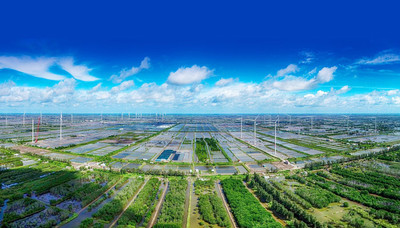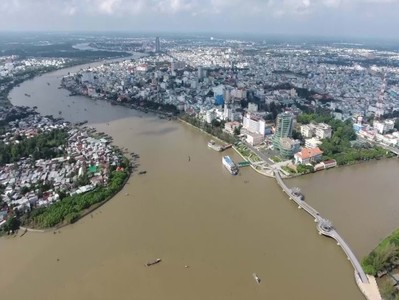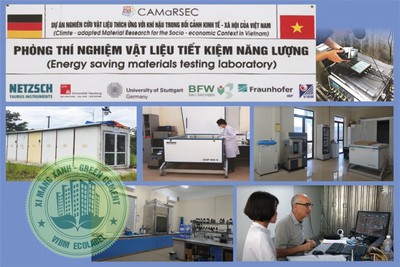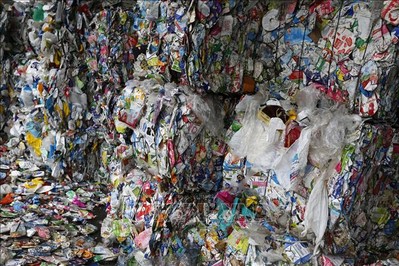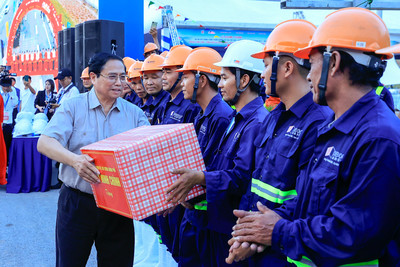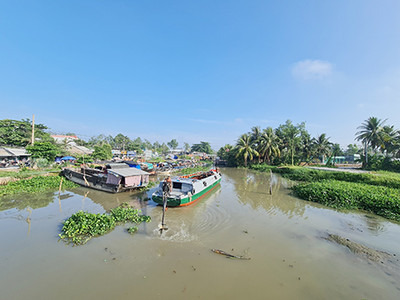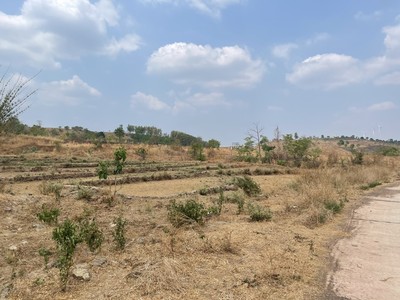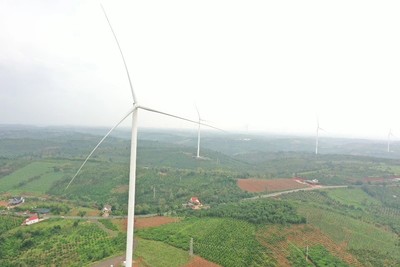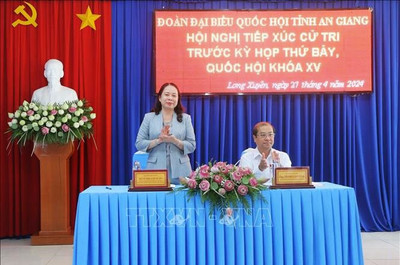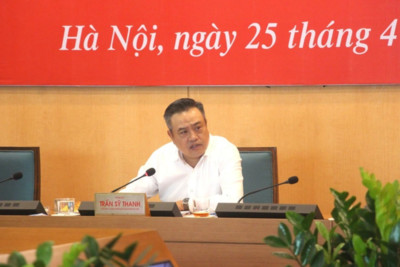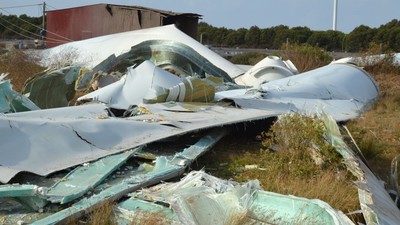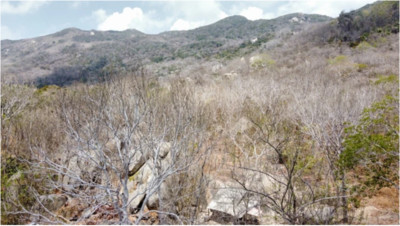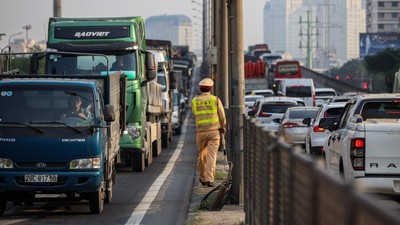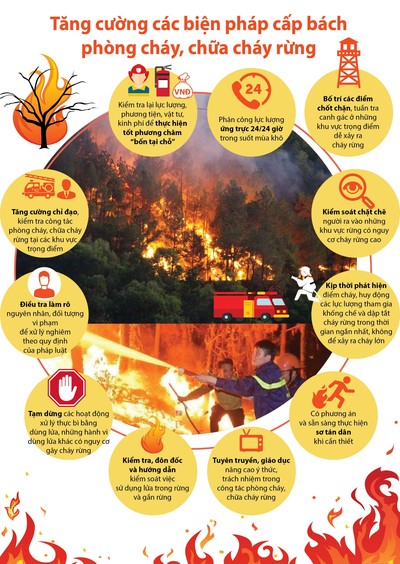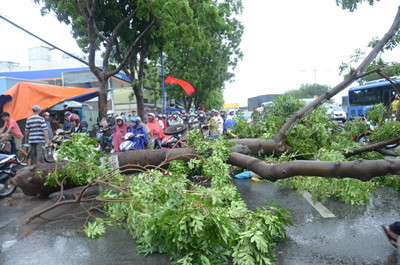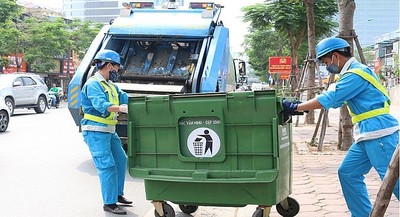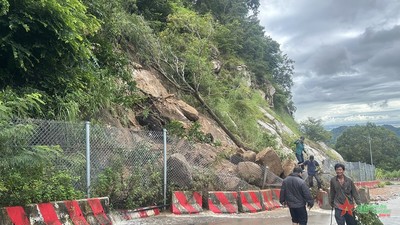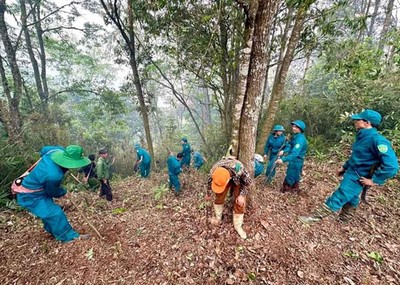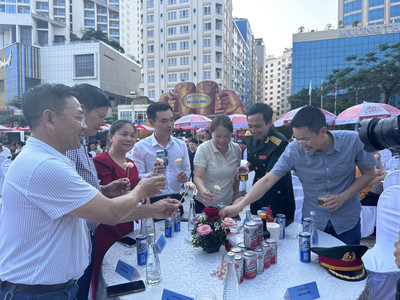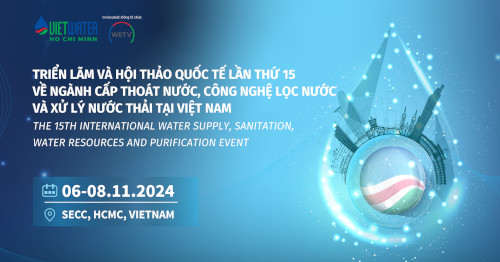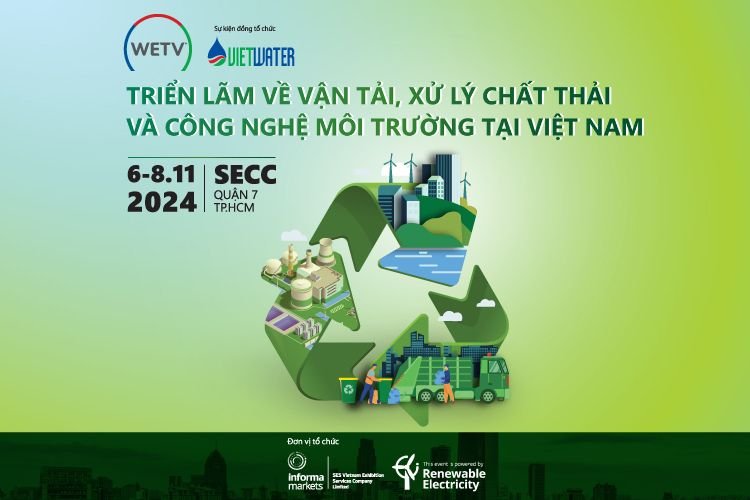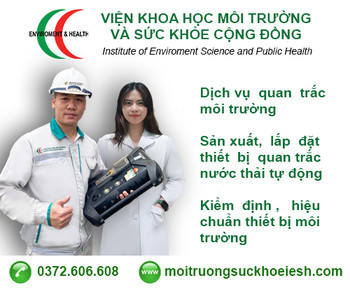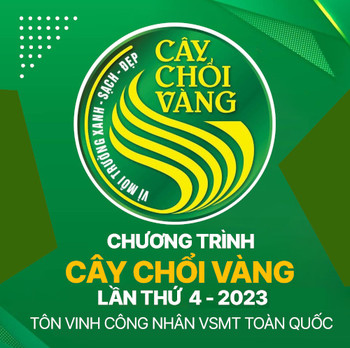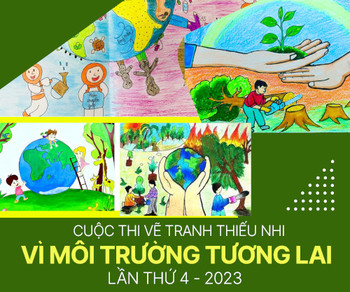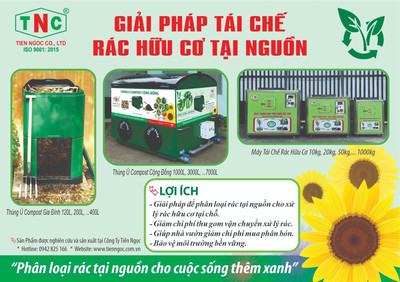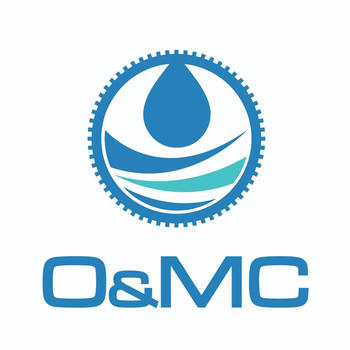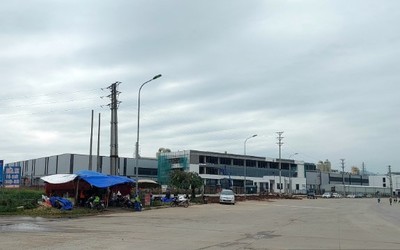Công bố quốc tế lĩnh vực môi trường số 27-2023
Trân trọng giới thiệu tới quý độc giả Công bố quốc tế lĩnh vực môi trường số 27-2023 với những nội dung chính như sau:
Về quản lý môi trường
- Đóng góp của nhựa và hạt vi nhựa đối với biến đổi khí hậu toàn cầu và các tác động liên quan của chúng đối với môi trường - Đánh giá.
- Phơi nhiễm lâu dài với vật chất hạt mịn và bệnh tim mạch: Vai trò giảm thiểu các mối quan tâm về môi trường.
- EU cần bảo vệ môi trường khỏi các chất per- và polyfluoroalkyl độc hại.
- Công khai thông tin môi trường có thể thu hút FDI? Minh chứng từ dự án PITI.
- Đánh giá kinh tế, môi trường và độ tin cậy của mạng lưới phân phối với lưu trữ năng lượng dựa trên carbon lỏng bằng cách sử dụng thuật toán tối ưu hóa giảng dạy nhóm đa mục tiêu.
- Tác động của các dịch vụ đối với cấu hình chuỗi cung ứng nhiên liệu hàng không bền vững: Trường hợp giảm phát thải CO2e ở Hoa Kỳ.
- Một mô hình màu xám rời rạc đa biến bị trễ không gian để dự báo một hệ thống kinh tế-năng lượng-môi trường.
- Đánh giá toàn diện các yếu tố môi trường ảnh hưởng đến hiệu suất của các tấm quang điện: Mối quan tâm về khí thải ở các giai đoạn khác nhau trong suốt vòng đời.
- Mối quan hệ giữa tài chính xanh, năng lượng tái tạo và cường độ carbon ở một số quốc gia châu Á được lựa chọn.
- Tác động của phí phát thải đến chất lượng đổi mới doanh nghiệp: Trên góc độ đổi mới công nghệ đột phá.
Về môi trường đô thị
- Ô nhiễm vi sinh vật trong các cửa hàng tạp hóa từ Bồ Đào Nha và Tây Ban Nha - Môi trường trong nhà bị bỏ quên cần được giải quyết.
- Đánh giá mức độ phơi nhiễm chất ô nhiễm bằng cách sử dụng máy đi bộ ảo và mô phỏng dòng xoáy lớn: Ứng dụng cho một khu đô thị lý tưởng.
- Thành tựu tự xi măng tự kích hoạt bằng kiềm và thăm dò cơ chế để xử lý tổng hợp tro bay của lò đốt chất thải rắn đô thị và đất nhiễm asen.
- Sự đóng góp của dòng vốn xuyên biên giới đối với quá trình khử cacbon.
- Sàng lọc dược phẩm và các sản phẩm chăm sóc cá nhân (PPCP) dọc theo hệ thống xử lý nước thải được trang bị xử lý vùng gốc: Một mô hình tiềm năng để quản lý nước rỉ rác sinh hoạt.
- Chỉ số chọn lọc cho các dự án hợp tác công tư trong lĩnh vực nước sạch và vệ sinh đô thị ở Châu Mỹ Latinh và Ca-ri-bê.
- Phát triển và thử nghiệm một giao thức để đánh giá một cách có hệ thống sự tương tác xã hội với môi trường đô thị ngoài trời.
- Tối ưu hóa hình thái khối đô thị dân cư dựa trên hiệu ứng tổng hợp của nó đối với môi trường chiếu sáng tự nhiên trong nhà và ngoài trời.
- Vi khí hậu đô thị và tác động của nó đến môi trường xây dựng - Tổng quan.
- Nghiên cứu tính khả thi của việc thu hồi nguồn carbon bằng lớp bùn kỵ khí dòng chảy ngược trong mô phỏng nước thải đô thị.
Về môi trường khu công nghiệp
- Nghiên cứu ảnh hưởng của sinh khối đến tính giải phóng lưu huỳnh từ quá trình đốt bùn nhuộm: Tập trung vào cơ chế cố định lưu huỳnh tại chỗ dựa trên các hợp chất mô hình.
- Thu hồi lưu huỳnh sinh học và tài nguyên kim loại từ nước thải mỏ bằng keo tụ oxy hóa-kiềm sinh học sunfua: Nghiên cứu quy mô thí điểm.
- Phát triển vật liệu composite MXene xử lý bề mặt công suất cao để loại bỏ kim loại nặng Cr(VI) trong nước thải công nghiệp.
- Các kỹ thuật phân tích gần đây và các tác động độc hại sinh thái tiềm tàng của vi nhựa sợi dệt (FMP) và các chất gây ô nhiễm liên quan: Đánh giá.
- Các yếu tố có khả năng gây độc trong bụi mịn bề mặt của quần xã cư trú tại các thành phố công nghiệp thung lũng.
- Loại bỏ và xử lý an toàn với môi trường vật liệu composite ferrihydrite/biosilica chứa As(III) và As(V).
- Chuyển đổi tuần hoàn trong quản lý nhựa giúp giảm lượng khí thải carbon của ngành nhựa.
- Những hiểu biết gần đây về lọc tĩnh điện và các ứng dụng tiềm năng của nó trong ngành thực phẩm.
- Một cách tiếp cận ưu tiên các rủi ro liên quan đến môi trường, xã hội và quản trị (ESG) liên quan đến nước đối với ngành khai thác mỏ: Trường hợp của Chile.

CHUYÊN TRANG QUẢN LÝ MÔI TRƯỜNG
Tạp chí Môi trường và Đô thị Việt Nam
Xin trân trọng giới thiệu!
QUẢN LÝ MÔI TRƯỜNG
1. Contribution of plastic and microplastic to global climate change and their conjoining impacts on the environment - A review
Science of The Total Environment, Volume 875, 1 June 2023, 162627
Abstract
Plastics are fossil fuel-derived products. The emissions of greenhouse gases (GHG) during different processes involved in the lifecycle of plastic-related products are a significant threat to the environment as it contributes to global temperature rise. By 2050, a high volume of plastic production will be responsible for up to 13 % of our planet's total carbon budget. The global emissions of GHG and their persistence in the environment have depleted Earth's residual carbon resources and have generated an alarming feedback loop. Each year at least 8 million tonnes of discarded plastics are entering our oceans, creating concerns regarding plastic toxicity on marine biota as they end up in the food chain and ultimately affect human health.
The unsuccessful management of plastic waste and its presence on the riverbanks, coastlines, and landscapes leads to the emission of a higher percentage of GHG in the atmosphere. The persistence of microplastics is also a significant threat to the fragile and extreme ecosystem containing diverse life forms with low genetic variation, making them vulnerable to climatic change. In this review, we have categorically discussed the contribution of plastic and plastic waste to global climate change covering the current plastic production and future trends, the types of plastics and plastic materials used globally, plastic lifecycle and GHG emission, and how microplastics become a major threat to ocean carbon sequestration and marine health. The conjoining impact of plastic pollution and climate change on the environment and human health has also been discussed in detail. In the end, we have also discussed some strategies to reduce the climate impact of plastics.
2. Impact of regional climate change on the mosquito vector Aedes albopictus in a tropical island environment: La Réunion
Science of The Total Environment, Volume 875, 1 June 2023, 162484
Abstract
The recent expansion of Aedes albopictus across continents in both tropical and temperate regions and the exponential growth of dengue cases over the past 50 years represent a significant risk to human health. Although climate change is not the only factor responsible for the increase and spread of dengue cases worldwide, it might increase the risk of disease transmission at global and regional scale. Here we show that regional and local variations in climate can induce differential impacts on the abundance of Ae. albopictus.
We use the instructive example of Réunion Island with its varied climatic and environmental conditions and benefiting from the availability of meteorological, climatic, entomological and epidemiological data. Temperature and precipitation data based on regional climate model simulations (3 km × 3 km) are used as inputs to a mosquito population model for three different climate emission scenarios.
Our objective is to study the impact of climate change on the life cycle dynamics of Ae. albopictus in the 2070-2100 time horizon. Our results show the joint influence of temperature and precipitation on Ae. albopictus abundance as a function of elevation and geographical subregion. At low-elevations areas, decreasing precipitation is expected to have a negative impact on environmental carrying capacity and, consequently, on Ae. albopictus abundance. At mid- and high-elevations, decreasing precipitation is expected to be counterbalanced by a significant warming, leading to faster development rates at all life stages, and consequently increasing the abundance of this important dengue vector in 2070-2100.
3. Long-term exposure to fine particulate matter and cardiovascular disease: The mitigation role of environmental concerns
Science of The Total Environment, Volume 875, 1 June 2023, 162656
Abstract
Although it is widely acknowledged that environmental concerns can reduce PM2.5 pollution, few studies have empirically estimated whether environmental concerns could bring health benefits by mitigating PM2.5 pollution. Here, we quantified government and media environmental concerns with text-mining algorithm, matched with cohort data along with high-resolution gridded PM2.5 data.
Accelerated failure time model and mediation model were used to explore the association between PM2.5 exposure and onset time to cardiovascular events, and the mitigation effect of environmental concerns. Every 1 μg/m3 increase in PM2.5 exposure was associated with shortened time to stroke and heart problem, with time ratios of 0.9900 and 0.9986, respectively. Each 1 unit increase in government and media environmental concerns, as well as their synergistic effect decreased PM2.5 pollution by 0.32 %, 0.25 % and 0.46 %, respectively; and decrease PM2.5 resulted in prolonged onset time to cardiovascular events. Mediation analysis revealed that reduced PM2.5 mediated up to 33.55 % of the association between environmental concerns and onset time to cardiovascular events, suggesting that other mediation pathways were also possible.
Associations of PM2.5 exposure and environmental concerns with stroke and heart problem were similar in different subgroups. Overall, environmental concerns reduce risks of cardiovascular disease by mitigating PM2.5 pollution and other pathways in a real-world data set. This study provides insights for low-and-middle-income countries to address air pollution and improve health co-benefit.
4. Environmental impact of adult incontinence products in China in the context of population aging
Science of The Total Environment, Volume 875, 1 June 2023, 162596
Abstract
With the rise of the aging population, the demand for adult incontinence products keeps increasing in developing countries. The increasing market demand for adult incontinence products will inevitably drive up upstream production, leading to more resources and energy consumption, carbon emissions, and heavier environmental pollution. It is imperative to explore the environmental impact of those products and seek opportunities to reduce the environmental impact, which is insufficient.
This study aims to fill the gap in research on comparative analysis of energy consumption, carbon emissions, and the environmental impact of adult incontinence products from a life cycle perspective under different energy saving and emission reduction scenarios in the context of aging in China. Based on empirical data from a top papermaking manufacturer in China, this study applies Life Cycle Assessment (LCA) method to analyze the impact of adult incontinence products from cradle to grave. Then different scenarios in the future are set to explore the potential of and the possible pathways for energy-saving and emission-reduction of adult incontinence products from the perspective of the whole life cycle.
The results indicate that the energy and materials inputs are the environmental hotspots of adult incontinence products. Under the future trend of the aging population, the predictable optimization of energy structure, optimization of material composition, and final disposal methods are far from being able to cope with the enormous environmental burden brought by the increase in the consumption of adult incontinence products, especially in 2060 which shows 3.33 to 18.40 times the annual environmental burden under the optimal energy saving and emission reduction scenario, compared to the base year 2020. Research on new environmentally friendly materials and recycling technology should be the focus of the technological development of adult incontinence products.
5. EU need to protect its environment from toxic per- and polyfluoroalkyl substances
Science of The Total Environment, Volume 876, 10 June 2023, 162770
Abstract
The Environmental Protection Agencies (EPAs) of Denmark, Sweden, Norway, Germany and the Netherlands submitted a proposal to the European Chemical Agency (ECHA) in February 2023 calling for a ban in the use of toxic industrial chemicals per- and polyfluoroalkyl substances (PFAS). These chemicals are highly toxic causing elevated cholesterol, immune suppression, reproductive failure, cancer and neuro-endocrine disruption in humans and wildlife being a significant threat to biodiversity and human health.
The main reason for the submitted proposal is recent findings of significant flaws in the transition to PFAS replacements that is leading to a widespread pollution. Denmark was the first country banning PFAS, and now other EU countries support the restrictions of these carcinogenic, endocrine disruptive and immunotoxic chemicals. The proposed plan is among the most extensive received by the ECHA for 50 years.
Denmark is now the first EU country to initiate the establishment of groundwater parks to try and protect its drinking water. These parks are areas free of agricultural activities and nutritious sewage sludge to secure drinking water free of xenobiotic including PFAS. The PFAS pollution also reflects the lack of comprehensive spatial and temporal environmental monitoring programs in the EU.
Such monitoring programs should include key indicator species across ecosystems of livestock, fish and wildlife, to facilitate detection of early ecological warning signals and sustain public health. Simultaneously with inferring a total PFAS ban, the EU should also push for more persistent, bioaccumulative and toxic (PBT) PFAS substances to be listed on the Stockholm Convention (SC) Annex A such as PFOS (perfluorooctane sulfonic acid) that is currently listed on the SCs Annex B. The combination of these regulative restrictions combined with groundwater parks and pan-European biomonitoring programs, would pave the way forward for a cleaner environment to sustain health across the EU.
6. Can environmental information disclosure attract FDI? Evidence from PITI project
Journal of Cleaner Production, Volume 403, 1 June 2023, 136861
Abstract
Based on the balanced panel data of 260 prefecture-level cities in China from 2005 to 2016, and the quasi-natural experiment of the Pollution Information Transparency Index (PITI) project implemented in 110 prefecture-level cities in 2009, this paper uses the spatial difference-in-differences (SDID) model and the spatial Dubin model (SDM) model to investigate the FDI attraction effect of environmental information disclosure (EID).
The results show that EID will significantly promote the inflow of FDI in cities, and this effect will be stronger with the increasing disclosure extent. EID has a siphon effect on FDI, that is, a city that has a better EID will attract more FDI than its neighbors, further intensifying the competition effect of FDI among cities with similar geographical distance, levels of economic development, and Internet penetration. The attraction effect of EID on FDI is mainly present in polluting cities and non-resource-based cities, while the impact on clean and resource-based cities is not significant.
7. Economic, environmental, and reliability assessment of distribution network with liquid carbon-based energy storage using multi-objective group teaching optimization algorithm
Journal of Cleaner Production, Volume 404, 10 June 2023, 136811
Abstract
In this paper, the optimum operation of a distribution network in the presence of renewable resources, and a new combined system of liquid carbon dioxide energy storage is investigated. A comprehensive structure is proposed for modeling and optimizing the combination of wind turbine and solar sources with the new energy storage system by considering their converters. Then, a multipurpose structure in the presence of these resources and the new storage resource is presented to overcome the uncertainty of the output power of renewable resources and improve the reliability of the grid.
To this end, first, by considering the probabilistic nature of wind and solar resources, a relatively comprehensive modeling of the system is presented. Economic costs, including the cost of setting up units, cost of generation, and emission of these units, are presented as optimization problem. The effects of the storage system on the load curve are investigated and discussed. The proposed objective function is determined based on optimal load distribution and technical constraints.
The multi-objective group teaching optimization algorithm is used to solve the microgrid optimal operation problem. The proposed model considering three cases, is successfully implemented on a 33-bus RBTS distribution network. The results indicated that the total cost of the proposed system in the first, second, and third case is decreased by about 2.88%, 21.78% and 21.2% compared to the base case study.
The cost reduction in the first case is due to the use of renewable energy sources, and this reduction in the second case is more due to the use of new storage. Finally, in the third case, due to the consideration of uncertainty and reliability index, compared to the second case, the amount of cost has increased slightly, but compared to the main case, there is a significant decrease, which indicates the superiority of the proposed model.
8. Impact of services on the supply chain configuration of sustainable aviation fuel: The case of CO2e emission reductions in the U.S.
Journal of Cleaner Production, Volume 404, 10 June 2023, 136934
Abstract
Aviation contributes to global warming through CO2, non-CO2 compound emissions, and aviation induced cloudiness. A suite of measures is needed to decarbonize the aviation sector, the most important being developing and deploying sustainable aviation fuel (SAF). Considerable interest exists in the impact of policies that incentivize the environmental services provided by SAF, and their influence on the return on investment to secure capital investment for production facilities.
This paper uses financial analysis and a system dynamics approach to analyze the effect of various policies on 1) the time required for a project to reach a positive net present value (NPV), 2) the magnitude of the NPV at the end of plant life, 3) investment risk and 4) potential regional supply development. Production of SAF from municipal solid waste through gasification Fisher-Tröpsch in the U.S. is used as a case study, and the U.S. Northwest for regional development.
The results indicate that a successful industry deployment entails strong support during the first three years of production to reach a positive NPV metric, after which it might be competitive with market-based initiatives or by leveraging economies of scale. Initiatives that target CO2e reductions, through criteria or purpose, generate a major impact. Alignment of strategies to increase fuel yield and emission reduction maximize profits. Stacking policies and programs, when maximizing SAF production, reduces the probability of financial loss under 13% for the three plant sizes assessed. This study demonstrates the importance of the valuation and inclusion of environmental services for project success.
9. A spatial lagged multivariate discrete grey model for forecasting an economy-energy-environment system
Journal of Cleaner Production, Volume 404, 10 June 2023, 136922
Abstract
To perform better future trend prediction for an economy-energy-environment (3E) system and address the shortcomings of traditional multivariate grey models, this paper introduces a spatial correlation term into the multivariate discrete grey model, thus creating the SLDGM(1,n) model, and improves the final calculation of the model according to the priority of new information. The validity of the SLDGM(1,n) model is assessed using data from the 3E system in North China, and the SLDGM(1,n) model is applied to predict the future trends of the 3E system in North China.
The following conclusions are obtained. First, the introduction of the spatial correlation term and the improvement of the final calculation method are reasonable; the prediction accuracy of the multivariate grey model is improved, and multiple systems are modeled simultaneously. Second, the SLDGM(1,n) model calculates the spatial spillover effect, and according to the simulation results for North China from 2010 to 2019, Hebei's energy consumption and carbon emissions are subject to the largest influence from other provinces, while its economic development level is subject to the smallest influence, and the carbon emissions of Shanxi and Inner Mongolia are subject to a negative spatial influence effect. Third, the prediction results indicate that under the effect of spatial correlation, the energy consumption of all five provinces in North China will continue to rise; the carbon emissions of Beijing will gradually decline while the carbon emissions of the other four provinces will all gradually rise, and the per capita GDP of the five provinces is expected to increase by more than 50% by 2025.
10. The role of climate literacy in individual response to climate change: evidence from China
Journal of Cleaner Production, Volume 405, 15 June 2023, 136874
Abstract
As a basic tool for understanding and making informed decisions about global warming, climate literacy could potentially affect the whole process from individual awareness to public engagement with global climate change. We conducted a nationwide online survey (N = 3067) to assess climate literacy in China and investigate its role in climate change concern and climate policy support. Respondents in our sample were generally well informed about the cause and public engagement dimensions of climate literacy, while demonstrated polarized performance in regard to the consequences of climate change.
Climate literacy is a stronger predictor of climate change concern and policy support than other variables such as demographics, experience, and values and can largely enhance the effects of media coverage through the mediation effect. Education and media coverage are found to be significantly associated with climate literacy, while climate experience has little to no effect on climate literacy. Our results somewhat undermine the central role of climate change concern in climate communications and public engagement. Instead, enhancing public climate literacy by disseminating scientific and result-based information from reliable institutions seems to be a more promising path in China.
11. Comprehensive review of environmental factors influencing the performance of photovoltaic panels: Concern over emissions at various phases throughout the lifecycle
Environmental Pollution, Volume 326, 1 June 2023, 121474
Abstract
Recently, solar photovoltaic (PV) technology has shown tremendous growth among all renewable energy sectors. The attractiveness of a PV system depends deeply of the module and it is primarily determined by its performance. The quantity of electricity and power generated by a PV cell is contingent upon a number of parameters that can be intrinsic to the PV system itself, external or environmental.
Thus, to improve the PV panel performance and lifetime, it is crucial to recognize the main parameters that directly influence the module during its operational lifetime. Among these parameters there are numerous factors that positively impact a PV system including the temperature of the solar panel, humidity, wind speed, amount of light, altitude and barometric pressure. On the other hand, the module can be exposed to simultaneous environmental stresses such as dust accumulation, shading and pollution factors. All these factors can gradually decrease the performance of the PV panel.
This review not only provides the factors impacting PV panel's performance but also discusses the degradation and failure parameters that can usually affect the PV technology. The major points include: 1) Total quantity of energy extracted from a photovoltaic module is impacted on a daily, quarterly, seasonal, and yearly scale by the amount of dust formed on the surface of the module. 2) Climatic conditions as high temperatures and relative humidity affect the operation of solar cells by more than 70% and lead to a considerable decrease in solar cells efficiency. 3) The PV module current can be affected by soft shading while the voltage does not vary.
In the case of hard shadowing, the performance of the photovoltaic module is determined by whether some or all of the cells of the module are shaded. 4) Compared to more traditional forms of energy production, PV systems offer a significant number of advantages to the environment. Nevertheless, these systems can procure greenhouse gas emissions, especially during the production stages. In conclusion, this study underlines the importance of considering multiple parameters while evaluating the performance of photovoltaic modules. Environmental factors can have a major impact on the performance of a PV system. It is critical to consider these factors, as well as intrinsic and other intermediate factors, to optimize the performance of solar energy systems. In addition, continuous monitoring and maintenance of PV systems is essential to ensure maximum efficiency and performance.
12. Nexus between green finance, renewable energy, and carbon intensity in selected Asian countries
Journal of Cleaner Production, Volume 405, 15 June 2023, 136822
Abstract
Long-term economic growth is dependent on the state of the energy sector in every given country. While green finance is gaining popularity due to its positive role in providing financial capital and funds for environmentally friendly ventures on a priority basis. Therefore, green finance and renewable energy technologies can play a crucial role in reducing carbon intensity. Hence, the study's primary objective is to estimate the impact of green finance and renewable energy on carbon intensity in 10 Asian economies.
This study has applied the panel quantile autoregressive distributed lag (QARDL) model to get the short and long-run estimates across several quantiles. The short and long-run estimates of green finance are a negatively significant impact on carbon intensity at all quantiles. The estimates of renewable energy consumption is a negatively significant impact on carbon intensity in only the long run at all quantiles. These results confirm that green finance and renewable energy consumption help reduce the carbon intensity in Asian economies. Moreover, the asymmetric impact of green finance and renewable energy consumption on carbon intensity is confirmed in the short and long run. The study provides various important policy suggestions that help in carbon neutrality targets.
13. Heterogeneity and influence factors of carbon productivity: Evidence from Chinese manufacturing enterprises
Journal of Cleaner Production, Volume 404, 10 June 2023, 136938
Abstract
Understanding influence factors and heterogeneity of carbon productivity in manufacturing enterprises can provide important guidance for designing carbon reduction policies. In this study, the heterogeneity of carbon productivity of Chinese manufacturing enterprises was measured by employing enterprise-level data from 2001 to 2011. The empirical findings demonstrated that carbon productivity did not show a decreasing trend over time, but the changing pattern varied across industries.
Based on a panel regression model, the result also found that both enterprise features and external factors significantly affected carbon productivity. Asset size, enterprise age, management level, export intensity, marketization level and etc. significantly increased carbon productivity, while enterprise financing and government subsidies decreased the productivity. In addition, effects of factors on carbon productivity differed by enterprise types, so governments should formulate differentiated environmental policies for various enterprises.
14. The impact of emission charges on the quality of corporate innovation: Based on the perspective of breakthrough technological innovation
Journal of Cleaner Production, Volume 404, 10 June 2023, 136830
Abstract
As China's longest-implemented market-based environmental regulation policy, emission charges have contributed outstandingly to improving the ecological environment and reducing firms' pollution emissions. We assess the impact of emission charges on the innovation quality of Chinese firms based on the perspective of firms' breakthrough technological innovation. By observing Chinese A-share listed firms with heavy pollution from 2011 to 2020, we find that corporate breakthrough technological innovation positively moderates the emission charges to enhance the quality of corporate innovation.
Our mechanism tests suggest that emission charges and breakthrough technological innovation positively affect innovation quality by improving the means of green innovation of enterprises. In addition, heterogeneity analysis shows that emission charges and firms' breakthrough technological innovation are only effective in improving the innovation quality of state-owned firms, and the effect on the innovation quality of non-state-owned firms is not significant. Our findings suggest that the imposition of emission charges and incentives for firms to embark on breakthrough technological innovation can effectively improve the quality of innovation.
15. Environmental and health impacts of PFAS: Sources, distribution and sustainable management in North Carolina (USA)
Science of The Total Environment, Volume 878, 20 June 2023, 163123
Abstract
Poly- and perfluoroalkyl substances (PFAS) are a class of manufactured chemicals that have recently attracted a great deal of attention from environmental regulators and the general public because of their high prevalence, resistance to degradation, and potential toxicity. This review summarizes the current state of PFAS and its effects on the environment of North Carolina, USA. Specific emphasis has been placed to identify i) the sources of PFAS in North Carolina ii) distribution of PFAS in different environmental segments of North Carolina, including surface water, groundwater, air, and sediment iii) drinking water contamination iv) impact of PFAS on human health v) PFAS accumulation in fish and other biota vi) status of PFAS removal from drinking water and finally vi) socioeconomic impact of PFAS uncertainties.
Continuous discharges of PFAS occur in the North Carolina environment from direct and indirect sources, including manufacturing sites, firefighting foam, waste disposal and treatment plants, landfill leachate, and industrial emissions. PFAS are widespread in many environmental segments of North Carolina. They are more likely to be detected in surface and groundwater sediments and can enter aquatic bodies through direct discharge and wet and dry deposition of emissions. Eventually, some adverse effects of PFAS have already been reported in North Carolina residents who could have been exposed to the chemicals through contaminated drinking water. Furthermore, PFAS were also found in blood samples from fish and alligators. PFAS were confirmed to be present in water, sediment, organic compounds, and aquatic species at all levels of the food web. However, there is still a substantial amount of work to be done to understand the actual contamination by PFAS in North Carolina comprehensively.
16. Adaptation to climate change: A study on regional climate change adaptation policy and practice framework
Journal of Environmental Management, Volume 336, 15 June 2023, 117666
Abstract
Although planning and policy instruments are important for climate change adaptation, the implementation of these measures is critical for success. This paper studies different climate change adaptation strategies by analysing the measures adopted by stakeholders in charge of government policy development and implementation to minimise the impacts of climate change in the northern tropical region of Queensland, Australia. Local government organisations are responsible for taking a leading role in climate change adaptation.
State and commonwealth government agencies are primarily responsible for developing climate transition policies and guidelines, as well as providing limited financial aid to help support the local government. Interviews were conducted with local government practitioners identified from different local government authorities in the study region. Although all the government bodies made some progress in developing better climate change adaptation policies, the interview participants identified that a lot more needs to be done, especially in implementation, including devising and the application of relevant action plans, economic assessments, stakeholder participations and engagement.
From a local government practitioners' viewpoint, both the water sector and local economy will face the highest immediate impacts if climate change adaptation actions are not adequately implemented at local government level in the study region. There are currently no notable legal bindings to address climate change risks in the region. In addition, financial liability assessments due to climate risks and cost-share mechanisms among different levels of stakeholders and government authorities to face and prepare for climate change impacts hardly exist.
Although the interview respondents recognise their high importance. As there are uncertainties in the achievements of climate change adaptation plans, from a local government practitioners’ standpoint, the local authorities should take appropriate actions to integrate adaptation and mitigation works to face and prepare for climate risks rather than focusing only on adaptation. The respondents informed that some work has been done to identify flood prone areas and a few policy documents exist that accommodate sea level rise in planning practice, but these are done in fragments with no holistic implementation, monitoring or evaluation plans put in place.
MÔI TRƯỜNG ĐÔ THỊ
1. Microbial contamination in grocery stores from Portugal and Spain - The neglected indoor environment to be tackled in the scope of the One Health approach
Science of The Total Environment, Volume 875, 1 June 2023, 162602
Abstract
Microbial contamination in grocery shops (GS) should be evaluated since food commodities are commonly handled by workers and customers increasing the risk of food contamination and disease transmission. The aim of this study was to evaluate the microbial contamination in Portuguese and Spanish GS with a multi-approach protocol using passive (electrostatic dust cloths and surface swabs) sampling methods. The molecular detection of Aspergillus sections, mycotoxin analysis, screening of azole resistance as well as cytotoxicity measurement were conducted to better estimate the potential health risks of exposure and to identify possible relations between the risk factors studied.
Fruits/vegetables sampling location was the one identified has being the most contaminated (bacteria and fungi) area in GS from both countries. Aspergillus section Fumigati and Fusarium species were observed in samples from Portuguese groceries with reduced susceptibilities to azoles commonly used in the clinical treatment of fungal infections. Fumonisin B2 was detected in Portuguese GS possible unveiling this emergent threat concerning occupational exposure and food safety. Overall, the results obtained raise concerns regarding human health and food safety and must be surveilled applying a One Health approach.
2. Fog scavenging of particulate matters in air pollution events: Observation and simulation in the Yangtze River Delta, China
Science of The Total Environment, Volume 876, 10 June 2023, 162728
Abstract
Stable atmospheric boundary layer is conducive to the accumulation of atmospheric pollution and the occurrence of fog, and fog has a removal effect on air pollution. In this study, we use the observation and WRF-Chem (Weather Research and Forecasting Model with Chemistry) simulation to analyze the factors affecting the removal efficiency in a continuous fog and haze episode from November 26 to 28, 2018 in Jiangsu Province, such as fog thickness and duration. The results show that the WRF-Chem simulation well reproduces the boundary layer characteristics in the stages of fog formation, development and dissipation. The atmospheric boundary layer provides favorable conditions for the maintenance of fog and air pollution. The inversion layer, with the maximum intensity of 3 °C per 100 m, creates favorable thermal conditions, and the water vapor advection is also conducive to the fog maintenance. The ground observation verifies the wet scavenging of PM2.5 during dense fog events. The scavenging effect is related to the fog duration, and the correlation is positive when the fog is just formed and negative when the fog is dissipating. The PM2.5 concentration decreases from 159 μg m−3 to 38 μg m−3 after the fog lasts for 11 h. The fog has a remarkable scavenging effect on PM2.5 in the vertical direction, due to the deposition effect of fog droplets on the pollutant particles. The PM2.5 concentration on the ground is lower than the vertical average in the fog area, and the scavenging effects during the dense fog periods on November 27 and 28 are 47.7 μg m−3 and 36.1 μg m−3, respectively. The fog duration is mostly concentrated in 3-17 h. When the duration of fog is 4-8 h, the scavenging effect on PM2.5 reaches the strongest, with an average PM2.5 concentration decrease of >70 μg m−3.
3. Evaluation of pollutant exposure using virtual walkers and large-eddy simulation: Application to an idealised urban neighbourhood
Science of The Total Environment, Volume 877, 15 June 2023, 162640
Abstract
Urban air quality studies have primarily focused on pollutant dispersion; however, spatial or temporal concentrations collected at discretely distributed grid points (or fixed receptors) do not reflect the actual pollutant exposure of pedestrians. Using large-eddy simulation (LES) with virtual walkers implemented, this study investigates pollutant exposure of walking agents (or moving receptors) in an urban turbulent boundary-layer flow developed over an aligned building array under the influence of different wind directions. The spatial variability of the exposure risks are found to be better captured by the moving receptors than the fixed receptors along the same agent walking tracks. We demonstrate that the actual exposure can differ significantly from results interpreted from data recorded by the fixed receptors (corresponding to Eulerian estimates) and show that large discrepancies occur in avenues near the source, wherein dispersion of the point release has not occurred on larger spatiotemporal scales. In most scenarios, optimal evacuation routes are shown to be ones that deviate as much as possible from the dominant wind direction; however, one needs to decide the priority of moving to further avenues first or immediately adjusting the walking direction. The results should serve as a useful baseline reference for environmental health impact assessment and evacuation route planning against hazardous releases of air pollutants in more complex urban environments.
4. Self-alkali-activated self-cementation achievement and mechanism exploration for the synergistic treatment of the municipal solid waste incineration fly ashes and the arsenic-contaminated soils
Chemosphere, Volume 325, June 2023, 138397
Abstract
The feasibility and potential mechanisms of the self-alkali activation brought by municipal solid waste incineration (MSWI) fly ashes to the self-cementation of arsenic-contaminated soils were quantitatively evaluated and comprehensively analyzed to avoid the additional application of the alkali activators and binder materials traditionally. The employment of the two kinds of precursor materials achieved the self-alkali-activated self-cementation (‘double self’) under ambient conditions. The largest compressive strength (MPa) of 25.64 and lowest leaching toxicities (mg/L) of 21.05, 2.86, 0.08, 0.02, 2.05, and 0.34 for Zn, Cu, Cr, Cd, Pb, and As were obtained in the solidified matrix. Geopolymerization kinetics of the ‘double self’ cementation can be mathematically fitted by the Johnson-Mehl-Avrami-Kolmogorov model. CaClOH and halite in the MSWI fly ashes set up the self-alkali activation by reacting with the kaolinite and quartz in soils contaminated with arsenic by forming layered hydration and three-dimensional geopolymerization products to push for self-cementation.
5. The contribution of cross-border capital flow towards decarbonisation
Journal of Cleaner Production, Volume 405, 15 June 2023, 137040
Abstract
This study examines the effects of greenfield foreign direct investment, mergers and acquisitions, and net foreign direct investment inflows, on carbon dioxide emissions in 68 countries from 1996 to 2018. The investigation adopts an augmented Stochastic Impacts by Regression on the Population, Affluence, and Technology (STIRPAT) framework and employs an instrumental variable approach and instrumental variable-quantile regression models for the sampled nations. Whilst several Foreign Direct Investment entry modes are shown to have varying effects, the results demonstrate that capital inflows via greenfield foreign direct investment and net foreign direct investment raise emissions in all nations, confirming the Pollution Haven Hypothesis. Also, the unrestricted inflows of capital via greenfield projects could increase environmental degradation overtime and the detrimental impact could spread to other sectors of the economy.
Moreover, our study demonstrates that capital inflow through cross-border mergers and acquisitions is a significant contributor to decarbonisation throughout the analysed nations, confirming the halo hypothesis, with quantile results revealing diverse effects across national emission profiles. The results are robust to different model specifications of the independent variables and estimation methods. Based on the empirical findings, several policy implications are suggested for theory and practice on cleaner production and sustainability in the countries and multinational companies. This study recommends policy measures to regulate the inflow of polluting assets and incentives to contribute to decarbonisation solutions.
6. Screening of pharmaceutical and personal care products (PPCPs) along wastewater treatment system equipped with root zone treatment: A potential model for domestic waste leachate management
Journal of Environmental Management, Volume 335, 1 June 2023, 117494
Abstract
We present the use of root zone treatment (RZT) based system for the removal of pharmaceutical and personal care products (PPCPs) from domestic wastewater. The occurrence of more than a dozen PPCPs were detected in an academic institution wastewater treatment plant (WWTP) at three specific locations, i.e., influent, root treatment zone, and effluents. The comparisons of observed compounds detected at various stages of WWTP suggest that the presence of PPCPs, like homatropine, cytisine, carbenoxolone, 4,2′,4′,6′-tetrahydroxychalcone, norpromazine, norethynodrel, fexofenadine, indinavir, dextroamphetamine, 3-hydroxymorphinan, phytosphingosine, octadecanedioic acid, meradimate, 1-hexadecanoyl-sn-glycerol, and 1-hexadecylamine, are unusual than the usual reported PPCPs in the WWTPs. In general, carbamazepine, ibuprofen, acetaminophen, trimethoprim, sulfamethoxazole, caffeine, triclocarban, and triclosan are often reported in wastewater systems. The normalized abundances of PPCPs range between 0.037-0.012, 0.108-0.009, and 0.208-0.005 in main influent, root zone effluent, and main effluents, respectively, of the WWTP. In addition, the removal rates of PPCPs were observed from −200.75% to ∼100% at RZT phase in the plant. Interestingly, we observed several PPCPs at later stages of treatment which were not detected in the influent of the WWTP.
This is probably owing to the presence of conjugated metabolites of various PPCPs present in the influent, which subsequently got deconjugated to reform the parent compounds during the biological wastewater treatment. In addition, we suspect the potential release of earlier absorbed PPCPs in the system, which were absent on that particular day of sampling but have been part of earlier influents. In essence, RZT-based WWTP was found to be effective in removing the PPCPs and other organic contaminants in the study but results in stress the need for further comprehensive research on RZT system to conclude the exact removal efficacy and fate of PPCPs during treatment in the system. As a current research gap, the study also recommended RZT to be appraised for PPCPs in-situ remediation from landfill leachates, an underestimated source of PPCPs intrusion in the environment.
7. A selectivity index for public-private partnership projects in the urban water and sanitation sector in Latin America and the caribbean
Journal of Environmental Management, Volume 335, 1 June 2023, 117564
Abstract
The rapid urban development, the Agenda 2030, the climate change adaptation and the COVID 19 crisis highlight the need to increase investment in public infrastructure and improve water supply and sanitation services. For this, an alternative to traditional public procurement is the participation of the private sector under the public-private partnership (PPP) model. The objective of this article is to develop a tool based on critical success factors (CSFs) that allows for evaluation during early stages of the convenience of developing a PPP project for W&S in urban areas of Latin America and the Caribbean.
The index was developed based on literature review (779 variables), review of cases (20 variables) and expert opinion to assign them an estimated value of importance. The results were analysed by exploratory and confirmatory factor analysis, selecting 17 main variables grouped into 6 CSFs, the most relevant of which are Convenience, Certainty, Leadership, Attraction, Performance and Reliability. The application of this index allows an early assessment of the feasibility of a PPP project and/or the selection of the alternatives with the best chances of success. On the other hand, this study contributes to the international discussion on the most relevant elements related to the success of PPP in W&S projects.
8. Emission of VOCs from service stations in Beijing: Species characteristics and pollutants co-control based on SOA and O3
Journal of Environmental Management, Volume 336, 15 June 2023, 117614
Abstract
Currently, air pollution is primarily characterized by PM2.5 and O3. Therefore, the co-control of PM2.5 and O3 has become an important task of atmosphere pollution prevention and control in China. However, few studies have been conducted on the emissions from vapor recovery and processes, which is an important source of VOCs. This paper analyzed the VOC emissions of three vapor process technologies in service stations and first proposed key pollutants for priority control based on the coordinated reactivity of O3 and SOA. The concentration of VOCs emitted from the vapor processor was 3.14-9.95 g m−3, compared to 631.2-717.8 g m−3 for uncontrolled vapor. Alkanes, alkenes, and halocarbons accounted for a high proportion of the vapor both before and after control. Among the emissions, i-pentane, n-butane, and i-butane were the most abundant species.
Then, the species of OFP and SOAP were calculated through the maximum incremental reactivity (MIR) and fractional aerosol coefficient (FAC). The average source reactivity (SR) value of the VOC emissions from three service stations was 1.9 g g−1, while the OFP ranged from 8.2 to 13.9 g m−3 and SOAP ranged from 0.18 to 0.36 g m−3. By considering the coordinated chemical reactivity of O3 and SOA, a comprehensive control index (CCI) was proposed for the control of key pollutant species that have multiplier effects on environment. For adsorption, trans-2-butene and p-xylene were the key co-control pollutants, while toluene and trans-2-butene were the most important for membrane and condensation + membrane control. A 50% emission reduction of the top two key species that emission account for 4.3% averagely will reduce O3 by 18.4% and SOA by 17.9%.
9. Developing and testing a protocol to systematically assess social interaction with urban outdoor environment
Journal of Environmental Psychology, Volume 88, June 2023, 102008
Abstract
Social interaction is significant for individuals’ mental and psychological well-being in communities. With the growing demand for outdoor activities in urban settings under the COVID‑19 pandemic, urban parks have become important public resources for human social activities. Researchers have developed numerous instruments to measure park use behaviors, but most are designed for assessing physical activity while ignoring social interactive behaviors. Despite the importance, no single protocol objectively assesses the range of social interactions in urban outdoor environments. To bridge the research gap, we have developed a social interaction scale (SIS) based on Parten's scheme.
The innovative protocol, named Systematically Observing Social Interaction in Parks (SOSIP) was developed based on the SIS, allowing systematic evaluation of human’s interactive behaviors in outdoor environment both from their levels of social interaction and group size. The psychometric properties of SOSIP were established through the verification of content validity and reliability tests. Additionally, we applied SOSIP to explore relationships between park features and social interaction via hierarchical linear models (HLMs). Statistical comparisons between SOSIP and other forms of social interaction were discussed and indicated strong reliability of applying SOSIP. The results indicated SOSIP is a valid and reliable protocol for objectively assessing social interactive behaviors within urban outdoor environments and informing better understanding of individuals' mental and psychological health benefits.
10. Analyzing "Economy-Society-Environment" sustainability from the perspective of urban spatial structure: A case study of the Yangtze River Delta Urban Agglomeration
Sustainable Cities and Society, Available online 2 June 2023, 104691
Abstract
Sustainable urban development is a common concern of humanity. In order to achieve high-quality urban development, it is imperative to measure cities' sustainability gaps within urban agglomerations and explore the factors affecting sustainability. However, most studies focus on factors at the municipal scale, and the role of intra-urban structure and inter-urban interactions in urban sustainability remains unclear. To address these issues, we analyzed 17 Sustainable Development Goals (SDG) of each city within the Yangtze River Delta Urban Agglomeration (YRDUA), and explored the spatial distribution differences of urban sustainability. In addition, we quantified the impact of urban functional areas, land use, space of flows, geographical location, and climate on "Economy-Society-Environment" (ESE) system by applying the random forest algorithm (RFA)-SHapley Additive exPlanations (SHAP) model.
The results show that the eastern YRDUA (coastal area) has outstanding ESE system coordination; the northern YRDUA (heavy industrial area) performs well in economic sustainability but not in the environment; the southwestern YRDUA (high-density forest area) has better environmental performance than its economy and society. Improving transportation facilities and promoting inter-city cooperation are beneficial to economic sustainability; improving social well-being contributes to social sustainability; reducing carbon emissions and protecting urban green areas are crucial for environmental sustainability.
11. Optimization of Residential Urban-Block Morphology Based on Its Synthetic Effects on Indoor and Outdoor Natural Lighting Environments
Sustainable Cities and Society, Available online 2 June 2023, 104698
Abstract
The qualities of indoor and outdoor natural lighting environments are important aspects of sustainable urban design, which are inseparable, especially in high-density cities. This study aimed to reveal the synthetic effects of mesoscale urban morphology on indoor and outdoor natural lighting environments and propose corresponding design strategies for the sustainability of cities. Through data mining, 1680 residential blocks in Hangzhou, China, were selected for simulation analysis; urban morphology indicators that have a significant influence on daylighting performance were extracted.
A multi-objective optimization algorithm was adopted to explore the optimal morphological features of urban morphology within a typical site. The extracted features were verified by morphological modifications in real cases. 1) The floor area ratio had the most significant effect on indoor daylighting (p= -0.673), while density was the most influential indicator for outdoor environments (p= -0.406); 2) in a typical site, morphological optimization can effectively improve lighting quality, with the average daylighting factor and sky view factor increasing by 3.7 and 6.7%, respectively; 3) two design strategies can simultaneously improve the indoor and outdoor natural lighting: dispersing the overall building mass to the perimeter of the site and dispersing the slab buildings of large masses as much as possible.
12. Urban microclimate and its impact on built environment - A review
Building and Environment, Volume 238, 15 June 2023, 110334
Abstract
Increasing urbanization and population growth have brought attention to urban microclimates in recent years. The study on urban microclimate and its impact on the built environment is gaining momentum. A growing number of researchers have examined the relationship between human activity and the immediate surroundings to reduce adverse impacts on the environment and climate.
This paper presents the latest progress in urban microclimate research on urban wind and thermal environment, covering traditional methods, including field measurements, wind tunnel modeling, and CFD simulations, as well as emerging methods, such as artificial intelligence or data-driven models. Among the publications reviewed, the topics include isothermal scenarios that neglected thermal aspects (e.g., urban wind energy, wind comfort), as well as thermal scenarios (e.g., urban heat islands and outdoor thermal comfort). In the review, it was found that CFD has been widely applied due to its well-developed nature. In addition to field measurements, new techniques (such as satellite and thermal imaging) provide valuable validation data for CFD and training data for artificial intelligence applications. In isothermal scenarios, wind tunnel modeling has been successfully applied. However, thermal scenarios present significant challenges. In addition, urban data-driven models have emerged with promising results, but systematic investigations have been limited. In this paper, we identify future research needs for urban microclimates based on an overview of recent progress.
13. Heterogeneous characteristics and absorption enhancement of refractory black carbon in an urban city of China
Science of The Total Environment, Volume 879, 25 June 2023, 162997
Abstract
In this study, field measurement was conducted using an integrated online monitoring system to characterize heterogeneous properties and light absorption of refractory black carbon (rBC). rBC particles are mainly from the incomplete combustion of carbonaceous fuels. With the data collected from a single particle soot photometer, thickly coated (BCkc) and thinly coated (BCnc) particles are characterized with their lag times. With different responses to the precipitation, a dramatical decline of 83 % in the number concentration of BCkc is shown after rainfall, while that of BCnc decreases by 39 %. There is a contrast in core size distribution that BCkc is always with larger particle sizes but has smaller core mass median diameters (MMD) than BCnc. The mean rBC-containing particle mass absorption cross-section (MAC) is 6.70 ± 1.52 m2 g−1, while the corresponding rBC core is 4.90 ± 1.02 m2 g−1. Interestingly, there are wide variations in the core MAC values which range by 57 % from 3.79 to 5.95 m2 g−1, which are also closely related to those of the whole rBC-containing particles with a Pearson correlation of 0.58 (p < 0.01). Errors would be made if we eliminate the discrepancies and set the core MAC as a constant when calculating absorption enhancement (Eabs). In this study, the mean Eabs is 1.37 ± 0.11 while the source apportionment shows that there are five contributors of Eabs including secondary aging (37 %), coal combustion (26 %), fugitive dust (15 %), biomass burning (13 %) and traffic-related emissions (9 %). Secondary aging is found to be the highest contributor due to the liquid phase reactions in formations of secondary inorganic aerosol. Our study characterizes property diversities and provides insights into the sources impacting the light absorption of rBC and will be helpful for controlling it in the future.
14. Study on the feasibility of carbon source recovery by upflow anaerobic sludge blanket in simulated municipal wastewater
Science of The Total Environment, Volume 878, 20 June 2023, 163157
Abstract
The influence of hydraulic retention time (HRT) on the granulation process, methane-producing capacity, microbial community structure, and pollutant removal efficiency of an up-flow anaerobic sludge blanket (UASB) with simulated municipal wastewater at a mesophilic temperature was investigated. The carbon recovery capacity of the anaerobic fermentation of municipal wastewater at mesophilic temperatures is one of the problems to be investigated for the realisation of carbon neutrality in municipal wastewater treatment plants. In this study, the HRT was gradually shortened (24-6 h), and the effluent chemical oxygen demand (COD), ammonia nitrogen, pH, volatile fatty acid concentration, and specific methanogenic activity (SMA) were investigated. The sludge morphology, the particle size distribution of the different HRT, and changes in the microbial community structure were determined by scanning electron microscopy, wet screening, and high-throughput sequencing. The results indicated that even if the COD concentration was only 300-550 mg/L, with a decrease in HRT, the proportion of granular sludge in the UASB still exceeded 78 %, and the COD removal efficiency reached 82.4 %.
The SMA of granular sludge increased with an increase in the size of granules and was 0.289 g CH4-COD/(g VSS d) at an HRT of 6 h, but the proportion of dissolved methane in the effluent accounted for 38-45 % of the total methane production and the proportion of Methanothrix in UASB sludge was 82.44 %. In this study, dense granular sludge was obtained by gradually shortening the HRT to start the UASB, and the lower effluent COD reduced the load of subsequent treatment processes, which could be used as a low carbon/nitrogen ratio influent for activated carbon-activated sludge, activated sludge-microalgae, and partial nitrification-anaerobic ammonia oxidation processes.
15. Abundance, characteristics, and ecological risks of microplastics in the riverbed sediments around Dhaka city
Science of The Total Environment, Volume 877, 15 June 2023, 162866
Abstract
Microplastic (MP) pollution has become an escalating problem in Bangladesh due to its rapid urbanization, economic growth, and excessive use of plastics; however, data on MP pollution from fresh water resources in this country are limited. This study investigated microplastics pollution in riverbed sediments in the peripheral rivers of Dhaka, the capital of Bangladesh. Twenty-eight sediment samples were collected from the selected stations of the Buriganga, Turag, and Balu Rivers. Density separation and wet-peroxidation methods were employed to extract MP particles. Attenuated total reflectance-Fourier transform infrared spectroscopy was used to identify the polymers. The results indicated a medium-level abundance of MPs in riverbed sediment in comparison with the findings of other studies in freshwater sediments worldwide.
Film shape, white and transparent color, and large-size (1-5 mm) MPs were dominant in the riverbed sediment. The most abundant polymers were polyethylene (PE), polypropylene (PP), and polyethylene terephthalate (PET). Pollution load index (PLI) values greater than 1 were observed, indicating that all sampling sites were polluted with MPs. An assessment of ecological risks, using the abundance, polymer types, and toxicity of MPs in the sediment samples, suggested a medium to very high ecological risk of MP pollution of the rivers. The increased abundance of MPs and the presence of highly hazardous polymers, namely; polyurethane, acrylonitrile butadiene styrene, polyvinyl chloride, epoxy resin, and polyphenylene sulfide, were associated with higher ecological risks. Scanning electron microscopy (SEM) analysis indicated that the MPs were subjected to weathering actions, reducing the size of MPs, which caused additional potential ecological hazards in these river ecosystems. This investigation provides baseline information on MP pollution in riverine freshwater ecosystems for further in-depth studies of risk assessment and developing strategies for controlling MP pollution in Bangladesh.
16. A multicomponent index method to evaluate the relationship between urban environment and CHD prevalence
Spatial and Spatio-temporal Epidemiology, Volume 45, June 2023, 100569
Abstract
Cardiovascular disease (CVD) is the leading cause of death globally, coronary heart disease (CHD) is the main category of it. It has been shown that the urban built environment affects the occurrence of CHD, but most focus on single environmental factors. This study developed two multicomponent Urban Heart Health Environment (UHHE) Indexes (unweighted index and weighted index), which were based on the four main behavioral risk factors for CHD (unhealthy diet, lack of physical activity, smoking, and drinking).
And we examined the relationship between the indexes and the prevalence of CHD. The prevalence calculation is based on the database of F Hospital patients, who have had coronary stent implantation (CSI). Furthermore, these single-center data were corrected to reduce underestimation of prevalence. We performed global (Ordinal Least Square) and local (Geographically Weighed Regression) regression analyses to assess the relationship between the two UHHE indexes and CHD prevalence. Both indexes showed a significant negative relationship with CHD prevalence. In its spatial relationship, a non-stationary was discovered. The UHHE indexes may help identify and prioritize geographical areas for CHD prevention and may be beneficial to urban design in China.
MÔI TRƯỜNG KHU CÔNG NGHIỆP
1. Study on the effect of biomass on sulfur release behavior from dyeing sludge incineration: Focusing on in-situ sulfur fixation mechanism based on model compounds
Science of The Total Environment, Volume 875, 1 June 2023, 162544
Abstract
Although incineration is a recommended disposal strategy for dyeing sludge (DS), sulfurous gases problem is severe. Wood sawdust (WS) and rice husk (RH) are eco-friendly and CO2-neutral additives to relieve sulfur emission from DS incineration. However, the interaction between organic sulfur and biomass is uninterpreted. This study explores the effect of WS and RH on the combustion behavior and sulfur evolution from organic sulfur model compound combustion via thermogravimetry (TG) with mass spectrometry (MS). Results indicated that the sulfone and mercaptan combustion activities in DS were more drastic than in other forms.
WS and RH additives generally deteriorated the combustibility and burnout performance of model compounds. The combustion of mercaptan and sulfone in DS contributed to most gaseous sulfur pollutants, where CH3SH and SO2 were the predominant forms. WS and RH minimized the sulfur release from mercaptan and sulfone incineration, whose in-situ retention ratios reached 20.14 % and 40.57 %. The retention mechanism to sulfur could be divided into: (1) Diffusion stage: the closed structure of biomass residue restrained sulfurous gases from escaping. (2) Chemical reaction stage: multiple sulfation occurred and inhibited sulfur release. Ca/K sulfate and compound sulfates were predisposed and thermostable sulfur-fixing products for the mercaptan-WS and sulfone-RH co-combustion systems.
2. Recovery of bio‑sulfur and metal resources from mine wastewater by sulfide biological oxidation-alkali flocculation: A pilot-scale study
Science of The Total Environment, Volume 876, 10 June 2023, 162546
Abstract
Mine wastewater treatment using bio-sulfate reduction technology forms sulfur-containing wastewater that comprises sulfides (HS− and S2−) and metal ions. Bio‑sulfur generated by sulfur-oxidizing bacteria in such wastewater is usually negatively charged hydrocolloidal particles. However, bio‑sulfur and metal resource recovery are difficult using traditional methods. In this study, the sulfide biological oxidation-alkali flocculation (SBO-AF) method was investigated to recover the above resources, and to provide a technical reference for mine wastewater resource recovery and heavy metal pollution control. Specifically, the performance of SBO in forming bio‑sulfur and the key parameters of SBO-AF were explored and then applied in a pilot-scale process to recover resources from wastewater.
Results show that partial sulfide oxidation was achieved under a sulfide loading rate of 5.08 ± 0.39 kg/m3·d, dissolved oxygen of 2.9-3.5 mg/L and temperature of 27-30 °C. The average sulfide oxidation rate and sulfur selectivity ratio were 92.86 % and 90.22 %, respectively. At pH 10, metal hydroxide and bio‑sulfur colloids co-precipitated through the precipitation catching and adsorption charge neutralization effect. The average manganese, magnesium and aluminum concentrations and turbidity in the wastewater were 53.93 mg/L, 522.97 mg/L, 34.20 mg/L and 505 NTU, respectively, and decreased to 0.49 mg/L, 80.65 mg/L, 1.00 mg/L and 23.33 NTU, respectively, after treatment. The recovered precipitate mainly contained sulfur, along with metal hydroxides. The average sulfur, manganese, magnesium and aluminum contents were 45.6 %, 29.5 %, 15.1 % and 6.5 %, respectively. Economic feasibility analysis and the above results show that SBO-AF has obvious technical and economic advantages in the recovery resources from mine wastewater.
3. Development of high-capacity surface-engineered MXene composite for heavy metal Cr (VI) removal from industrial wastewater
Chemosphere, Volume 326, June 2023, 138448
Abstract
The substantial quantity of Cr(VI) contaminants in the aqueous atmosphere is a major environmental fear that cannot be overlooked. For the first time, MXene and chitosan-coated polyurethane foam have been employed for wastewater treatment, including heavy metal ions (Cr (VI)) through a fixed-bed column study. It is also the most inexpensive, lightweight, and globally friendly material tested. The Mxene and chitosan-coated polyurethane foam hybrid materials were thoroughly investigated using FTIR (Fourier transform infrared), SEM (scanning electron microscope), XPS (X-ray photoelectron spectroscopy) and XRD (X-ray diffraction).
The presence of the rough surface and the pore creation in the Mxene- MX3@CS3@PUF should rise its surface area, which is useful to interact the surface-active assembly of MX3@CS3@PUF and the Cr(VI) contaminations in the aqueous solution. With the help of the ion exchange mechanism and electrostatic contact, negatively charged MXene hexavalent ions were being adsorbed on the surface. MXene and chitosan have been coated on PUF foam in the form of three different layers, which shows the highest adsorption capacity, where up to ∼70% Cr (VI) was removed in the first 10 min and more than 60% elimination after 3 h when the metal ion concentration was 20 ppm. The electrostatic interaction between the negative charge MXene and the positive charge chitosan on the surface of PUF, which was absent in MX@PUF, is accountable for the high removal efficiency. This was done through a sequence of fixed-bed column studies, which took place in the continuous flowing of wastewater.
4. Recent analytical techniques, and potential eco-toxicological impacts of textile fibrous microplastics (FMPs) and associated contaminates: A review
Chemosphere, Volume 326, June 2023, 138495
Abstract
Despite of our growing understanding of microplastic's implications, research on the effects of fibrous microplastic (FMPs) on the environment is still in its infancy. Some scientists have hypothesized the possibility of natural textile fibres, which may act as one of the emerging environmental pollutants prevalent among microplastic pollutants in the environment. Therefore, this review aims to critically evaluate the toxic effects of emerging FMPs, the presence, and sources of FMPs in the environment, identification and analytical techniques, and the potential impact or toxicity of the FMPs on the environment and human health.
About175 publications (2011-2023) based on FMPs were identified and critically reviewed for transportation, analysis and ecotoxicological behaviours of FMPs in the environment. Textile industries, wastewater treatment plants, and household washing of clothes are significant sources of FMPs. In addition, various characterization techniques (e.g., FTIR, SEM, RAMAN, TGA, microscope, and X-Ray Fluorescence Spectroscopy) commonly used for the identification and analysis of FMPs are also discussed, which justifies the novelty aspects of this review. FMPs are pollutants of emerging concern due to their prevalence and persistence in the environment. FMPs are also found in the food chain, which is an alarming situation for living organisms, including effects on the nervous system, digestive system, circulatory system, and genetic alteration. This review will provide readers with a comparison of different analytical techniques, which will be helpful for researchers to select the appropriate analytical techniques for their study and enhance their knowledge about the harmful effects of FMPs.
5. Potentially toxic elements in surface fine dust of residence communities in valley industrial cities
Environmental Pollution, Volume 327, 15 June 2023, 121523
Abstract
A comprehensive analysis of content, pollution characteristics, health hazard, distribution, and source of some broadly concerned potentially toxic elements (PTEs, Pb, V, Mn, Cr, Ba, Zn, Ni, and Cu) in surface fine dust with particle size <63 μm (SFD63) from residence communities in Xi'an, a representative valley industrial city, was conducted in this research to analyze the quality of environment and influencing factors of valley industrial cities in China. The average contents of Ba (794.1 mg kg−1), Cu (61.3 mg kg−1), Pb (99.9 mg kg−1), Zn (408.1 mg kg−1), Cr (110.0 mg kg−1), and Ni (33.4 mg kg−1) in SFD63 of Xi'an residence communities surpassed their background contents of local soil.
The high enrichment-value regions of PTEs were chiefly located in the regions with high traffic flow, high population density, and areas around industries. Zn and Pb had moderate enrichment, and the overall pollution level of PTEs was unpolluted-to-moderate and moderate pollution. Three source categories (including natural geogenic source, industrial anthropogenic source, and mixed anthropogenic source of transportation, residential activities, and construction) were identified as the predominant sources for the PTEs pollution in SFD63, with the contribution levels of 29.9%, 32.4%, and 37.7%, respectively. The assessment of health risks according to Monte Carlo simulation revealed that the 95% of the non-cancer risk of PTEs to residents (the elderly, working people, and children) was less than the threshold of 1, while the probability of cancer risk exceeding the acceptable threshold of 1E-6 was 93.76% for children, 68.61% for the elderly, and 67.54% for working people. Industrial source was determined as priority pollution source and Cr was determined as priority pollutant, which should be concerned.
6. Feed-in tariffs and the carbon emission trading scheme under China's peak emission target: A dynamic CGE analysis for the development of renewable electricity
Journal of Environmental Management, Volume 335, 1 June 2023, 117535
Abstract
Thermal power industry is one of China's leading sources of carbon emissions. China has launched a national carbon emissions trading scheme (ETS) and renewable energy incentive programs to achieve its peak emission target by 2030. However, since 2021, China no longer provides a central feed-in tariff (FIT) for new centrally located solar photovoltaic (PV) power plants, commercial and industrially distributed PV projects, and newly approved onshore wind power projects. This change in policy may threaten China's carbon reduction targets and economic development.
Using a dynamic computable general equilibrium (CGE) model, we assess the combined effects of carbon ETS and FIT on China's electricity sector, carbon emission peak target, renewable energy and economic development. In terms of policy overlap and integration, we analyze the impact of these policies and estimate how to coordinate FIT and carbon ETS policies to ensure their effectiveness. Results show that the overall effects of FIT subsidies are superior to phasing-out FIT scenarios. The fiscal pressure caused by FIT is lower than its actual expenditure because it stimulates economic activity and boosts government revenue. However, considering the multiplier effect of the FIT on promoting government revenue growth and GDP growth, the most effective FIT should be terminated in 2025, followed by subsidies ending in 2030 and 2035.
7. Removal and environmentally safe disposal of As(III) and As(V)-loaded ferrihydrite/biosilica composites
Journal of Environmental Management, Volume 335, 1 June 2023, 117489
Abstract
Pure ferrihydrite and ferrihydrite-biosilica composite were synthesized and studied for the removal of As(III) and As(V). The synthesized materials have an adsorption capacity higher than some reported materials in the literature - 140 and 90 mg g− 1 for As(III) and As(V), respectively. The pH of the solution was shown to impact greatly on As(V) adsorption, but not on As (III), which is stable as a protonated, uncharged oxyanion, at pH < 9.2. The adsorption products were subjected to thermal treatment (500 ◦C for 2 h), promoting ferric arsenate formation.
The adsorbed As on ferrihydrite (Fh) was shown to inhibit the phase transformation of Fh to hematite. More so, thermal treatment was shown to oxidize As(III) to As (V). The changes in the adsorption residues after thermal treatment also had an impact on As mobility. The As (III) associated with the Fh phase increased from 42 to 95%, according to a sequential extraction protocol. Therefore, this work presents a process for As removal, followed by thermal treatment of arsenic-loaded ferrihydrites which enables environmentally safe disposal of As residues.
8. Multi-scenario simulation of land use and land cover based on shared socioeconomic pathways: The case of coastal special economic zones in China
Journal of Environmental Management, Volume 335, 1 June 2023, 117536
Abstract
Urban land-use change simulations without considering the sustainable planning policies, especially in special economic park highly concerned by planners, might lack the reliability and availability. Thus, this study proposes a novel planning support systems integrating the Cellular Automata Markov chain model and Shared Socioeconomic Pathways (CA-Markov-SSPs) for predicting the changing of land use and land cover (LULC) at the local and system level by using a novel machine learning-driven, multi-source spatial data modelling framework. Using multi-source satellite data of coastal special economic zones from 2000 to 2020 as a sample, calibration validation based on the kappa indicates a highest average reliability above 0.96 from 2015 to 2020, and the cultivated land and built-up land classes of LULC is the most significant changes in 2030 by using the transition matrix of probabilities, the other classes except water bodies continue to increase. And the non-sustainable development scenario can be prevented by the multiple level collaboration of socio-economic factors. This research intended to help decision makers to confine irrational urban expansion and achieve the sustainable development.
9. Identifying the nexus among environmental performance, digital finance, and green innovation: New evidence from prefecture-level cities in China
Journal of Environmental Management, Volume 335, 1 June 2023, 117554
Abstract
Globally, nations are increasingly focusing on green innovation in their environmental protection efforts as part of sustainable development, and digital finance is playing a vital role in enhancing green innovation. Employing annual data from 220 prefecture-level cities between 2011 and 2019, we empirically analyze the connections among environmental performance, digital finance, and green innovation via the Karavias panel unit root test with structural breaks, the Gregory-Hansen structural break cointegration test and pooled mean group (PMG) estimation. The following four points are the key conclusions: (1) The results support cointegration links between these variables when structural breaks are considered. (2) The PMG estimation outcomes indicate that green innovation and digital finance may have a favorable long-term effect on environmental performance. (3) For better environmental performance and more green innovation, the level of digitalization of digital finance is crucial. (4) The potential of digital finance and green innovation to improve environmental performance has not been fully realized in the western region of China.
10. Circular transformation in plastic management lessens the carbon footprint of the plastic industry
Materials Today Sustainability, Volume 22, June 2023, 100365
Abstract
Improper management of plastics showed a significant impact on climate change and biodiversity loss. Around 400 million tonnes of plastic waste (PW) have been generated so far and are projected to be doubled by 2040. Despite having plastic management rules worldwide, only 12% of PW is recycled and reused and the remaining waste directly enters the terrestrial and aquatic environment, leading to plastic pollution. It is noted that ∼1.7 GT of greenhouse gases releases into the environment during the production and incineration stages of plastics, demonstrating a higher carbon footprint and leading to climate change.
To overcome these issues, it is mandatory to curtail single-use plastics from everyday use and enhance the recycling option from the production to disposal stages, bringing circularity to the plastic industry. This paper recommends limiting the use of virgin plastics from fossil carbon and endorsing recycling and reusing PW as a secondary resource that can minimize the ∼3.0 kg CO2 emission per kg of plastics. Further, to promote a low-carbon economy in the plastic manufacturing process, the CO2 feedstock from fossil carbon can also be replaced by direct carbon capture and storage processes such as the power to x technology. This paper advocates setting up stepping milestones for a circular transformation in plastic industries that can reduce the carbon footprint by 25% and fulfill the target of the United Nations Sustainable Development Goals.
11. Recent insights on electrostatic filtration and its potential applications in food industry
Trends in Food Science & Technology, Volume 136, June 2023, Pages 239-250
Abstract
Background
Oil contamination is always hazardous for the environment. Contamination in hydraulic and lubricating system oils is unavoidable, resulting in tribological issues. To minimize such problems, a variety of oil cleansers have been developed, which have substantially improved the system's reliability.
Scope and approach
This review gathers the recent information regarding the electrostatic oil cleaners, their principle of filtration. Electrostatic oil cleansers remove polymerized oil oxidation products as well as micron-sized particle pollutants. Electrostatic observance is a resourceful tool for detecting and tracking flaws and degradation of components, which is mandatory for system health management. Tiny particles are electrostatically driven to capture positive or negative charge particles on electrodes whereas large particles get trapped in the filter.
Key findings and conclusions
Electrostatic filtration can be used to remove impurities from a liquid or solid food sample, usually by passing the sample through a filter made of charged particles. The charged particles attract the impurities, which are then removed from the sample. Electrostatic filtration can also be used to remove particulates, bacteria, viruses, and other contaminants. This method is often used in the food industry, as it is fast, efficient, and cost-effective. Electrostatic filters do not only show their best in the field of oil filtration but also in many other industries where their application is like in food industries for fine filtration in beverages as well as in the production field also. Thus, making these filters more applicable in the field of new industries and novel food processing techniques. The goal of this study is to raise awareness of both the technology's potential benefits and its existing research constraints to inspire greater research into this promising technology.
12. An approach for prioritising environmental, social and governance (ESG) water-related risks for the mining industry: The case of Chile
The Extractive Industries and Society, Volume 14, June 2023, 101259
Abstract
Mining projects interact with diverse concurrent environmental, social and governance (ESG) risks inherent to the local hosting context. These risks known as "situated risks'' usually have a relevant influence on the dynamics between operations, environment and communities. The appropriate assessment of these risks requires a multi-disciplinary approach. This research aims to propose a novel ESG-W-RISK approach to prioritise water-related ESG risks areas for the mining industry at a national scale. In contrast to similar approaches at a global scale, it uses tailored indicators and more detailed datasets for the country, which are selected based on an initial analysis of the national context. Indicators are assembled to create risk maps. Mining locations are overlaid with the risk maps to identify mining areas of high risk. ESG-W-RISK aims to support decision-makers by helping them identify the relevant water-related risk areas, and ultimately it can provide insights for developing country-level mitigation strategies. ESG-W-RISK was applied to Chile, a country with an important mining sector that faces relevant water-related challenges. The results show that 43% of current mines and 44% of future projects are in high-risk areas, and 93% of both mines and future projects are in areas of high or very high risk of water scarcity. Particularly, the risk levels in the Chile's lithium and copper mining areas are more concerning than the previously published global-scale ESG risk levels.
13. Historical trend and decarbonization pathway of China's cement industry: A literature review
Science of The Total Environment, Available online 5 June 2023, 164580
Abstract
The cement industry is one of the most energy- and carbon-intensive industries in China, and it is difficult to attain deep decarbonization toward carbon neutrality. This paper provides a comprehensive review of the historical emission trend and future decarbonization pathway of China's cement industry, in which the opportunities and challenges of key technologies, carbon mitigation potential and co-benefits are examined. The results showed that from 1990 to 2020, the carbon dioxide (CO2) emissions of China's cement industry experienced a growing trend, while air pollutant emissions were largely decoupled from cement production growth. Between 2020 and 2050, China's cement production may decrease by over 40 %, and CO2 emissions will decline from 1331 Tg to 387 Tg under the Low scenario given a combination of certain mitigation measures, including energy efficiency improvement, alternative energy sources, alternative materials, carbon capture, utilization, and storage (CCUS) technology, and new cement. Before 2030, carbon reduction under the low scenario is determined by factors including energy efficiency improvement, alternative energy sources, and alternative materials. Afterward, CCUS technology will become increasingly imperative and conducive to deep decarbonization of the cement industry. After implementation of all the above measures, 387 Tg of CO2 will still be emitted by the cement industry in 2050. As such, improving the quality and service life of buildings and infrastructure as well as the carbonation of cement materials has a positive effect on carbon reduction. Finally, carbon mitigation measures in the cement industry can provide air quality improvement co-benefits.
14. Balancing economic growth and environmental protection: A sustainable approach to Malaysia's rare-earth industry
Resources Policy, Volume 83, June 2023, 103753
Abstract
The rapid advancement of technology has highlighted the importance of rare earth elements (REE) for achieving sustainability. However, despite their potential, there are several challenges such as high demand, price fluctuations, supply risks, and unstable geopolitical landscapes that hinder their recovery efforts. Malaysia has been involved in the REE industry for decades, mainly by processing tin mining by-products into rare earth minerals (monazite). In 2012, Lynas, an Australian company, established a state-of-the-art manufacturing facility called Lynas Malaysia in the Gebeng Industrial Estate near the Port of Kuantan in Malaysia, where they separate and process Rare Earth materials from imported monazite (lanthanide concentrate) to produce Rare Earths Oxide (REO). However, the locals have raised concerns about the production of radioactive by-products, leading to an activist movement against Lynas.
To counter this, Malaysia aims to establish a comprehensive REE business strategy that utilizes local rare earth minerals. Although the extraction of REE from local ion adsorption clays (IC) has been advantageous with minimal issues relating to radioactive waste production, this review explores alternative local secondary sources that could be a sustainable REE source for Malaysia. The review also addresses the causes of the public protests and political interferences that jeopardize the industry's long-term sustainability. A progressive framework is proposed to improve current mineral processing practices and provide Malaysia with a viable rare-earth industry from upstream to downstream.
15. Co-occurrence and distribution of organophosphate tri- and di-esters in dust and hand wipes from an e-waste dismantling plant in central China
Science of The Total Environment, Volume 878, 20 June 2023, 163176
Abstract
Electronic waste (e-waste) dismantling facilities are a well-known source of emerging contaminants including organophosphate esters (OPEs). However, little information is available regarding the release characteristics and co-contaminations of tri- and di-esters. This study, therefore, investigated a broad range of tri- and di-OPEs in dust and hand wipe samples collected from an e-waste dismantling plant and homes as comparison. The median ∑tri-OPE and ∑di-OPE levels in dust and hand wipe samples were approximately 7- and 2-fold higher than those in the comparison group, respectively (p < 0.01). Triphenyl phosphate (median: 11,700 ng/g and 4640 ng/m2) and bis(2-ethylhexyl) phosphate (median: 5130 ng/g and 940 ng/m2) were the dominant components of tri- and di-OPEs, respectively.
The combination of Spearman rank correlations and the determinations of molar concentration ratios of di-OPEs to tri- OPEs revealed that apart from the degradation of tri-OPEs, di-OPEs could originate from direct commercial application, or as impurities in tri-OPE formulas. Significant positive correlations (p < 0.05) were found for most tri- and di-OPE levels between the dust and hand wipes from dismantling workers, whereas this was not observed in those from the ordinary microenvironment. Our results provide robust evidence that e-waste dismantling activities contribute to OPEs contamination in the surroundings and further human exposure pathways and toxicokinetics are needed to be elucidated.

